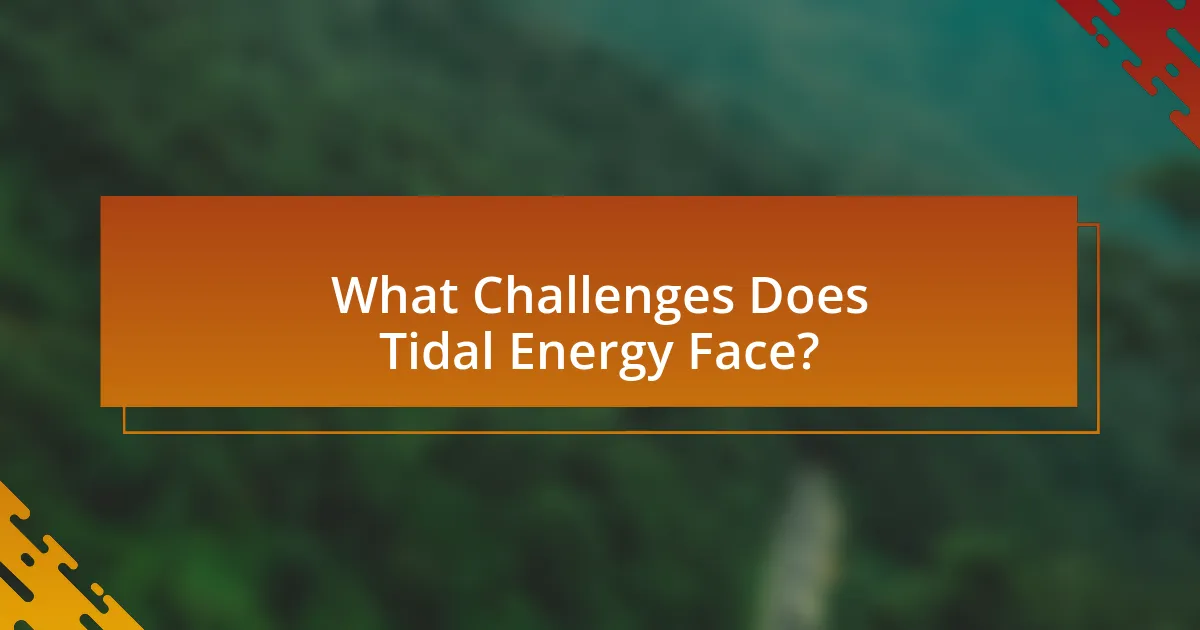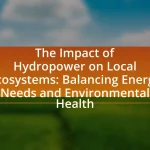Tidal energy, derived from the gravitational forces of the moon and sun on Earth’s oceans, presents a reliable and sustainable power source with the potential to generate up to 1,200 terawatt-hours of electricity annually. This article explores the unique characteristics of tidal energy, including its predictability compared to other renewable sources, the various technologies employed such as tidal stream and tidal range systems, and the current trends in development. It also addresses the challenges faced by the tidal energy sector, including high initial costs and environmental impacts, while highlighting global initiatives and advancements in technology that are shaping its future. The role of government policies, public perception, and collaborative efforts in promoting tidal energy adoption are also examined, providing a comprehensive overview of the potential and challenges of harnessing ocean currents for sustainable power.

What is Tidal Energy and Why is it Important?
Tidal energy is the energy generated from the gravitational pull of the moon and sun on Earth’s oceans, resulting in the rise and fall of sea levels. This form of renewable energy is important because it provides a predictable and sustainable source of power, with the potential to significantly reduce reliance on fossil fuels. According to the International Energy Agency, tidal energy has the capacity to generate up to 1,000 terawatt-hours of electricity annually, which could meet the energy needs of millions of households while contributing to climate change mitigation efforts.
How does tidal energy differ from other renewable energy sources?
Tidal energy differs from other renewable energy sources primarily in its predictability and reliance on gravitational forces exerted by the moon and sun. Unlike solar or wind energy, which are variable and dependent on weather conditions, tidal energy is consistent and can be accurately forecasted due to the regularity of tidal cycles. For instance, tidal patterns occur approximately every 12 hours, allowing for reliable energy generation schedules. This predictability enhances grid stability and energy management, making tidal energy a unique and dependable renewable resource.
What are the key characteristics of tidal energy?
Tidal energy is characterized by its reliance on the gravitational forces exerted by the moon and the sun, which create predictable and regular tidal movements. This energy source is renewable, as it harnesses the natural ebb and flow of ocean tides, making it sustainable over the long term. Tidal energy systems typically have low environmental impact compared to fossil fuels, as they produce minimal greenhouse gas emissions during operation. Additionally, tidal energy is highly predictable, with tidal patterns allowing for accurate forecasting of energy generation, unlike solar or wind energy, which can be intermittent. The efficiency of tidal energy conversion is also notable, with some technologies achieving conversion rates of up to 80%.
Why is tidal energy considered a sustainable power source?
Tidal energy is considered a sustainable power source because it harnesses the gravitational pull of the moon and sun, resulting in predictable and consistent energy generation. Unlike fossil fuels, tidal energy production does not emit greenhouse gases or pollutants, contributing to a cleaner environment. Additionally, the energy produced from tidal movements is renewable, as ocean tides are a natural and inexhaustible resource. According to the U.S. Department of Energy, tidal energy has the potential to generate up to 1,200 terawatt-hours of electricity annually, which could significantly reduce reliance on non-renewable energy sources.
What are the main types of tidal energy technologies?
The main types of tidal energy technologies are tidal stream systems and tidal range systems. Tidal stream systems utilize underwater turbines to capture the kinetic energy of moving water, similar to wind turbines capturing wind energy. Tidal range systems, on the other hand, exploit the difference in water levels between high and low tides, often using barrages or dams to generate electricity. These technologies are supported by various projects worldwide, such as the La Rance Tidal Power Station in France, which has been operational since 1966 and demonstrates the viability of tidal range systems.
How do tidal stream generators work?
Tidal stream generators work by converting the kinetic energy of moving water into electricity. These devices are typically installed on the seabed in areas with strong tidal currents. As water flows over the turbines, it causes the blades to rotate, which drives a generator to produce electrical power. The efficiency of tidal stream generators is enhanced by their design, which often includes features like adjustable blades to optimize energy capture based on varying water speeds. According to the International Energy Agency, tidal energy has the potential to provide up to 1,200 terawatt-hours of electricity annually, demonstrating its viability as a sustainable energy source.
What are the principles behind tidal range technologies?
Tidal range technologies operate on the principle of harnessing the gravitational forces exerted by the moon and the sun, which create predictable changes in sea levels known as tides. These technologies utilize the difference in water levels between high and low tides to generate energy, typically through the use of tidal barrages or turbines. Tidal barrages, for example, create a dam-like structure that captures water during high tide and releases it during low tide, driving turbines to produce electricity. The predictability of tidal patterns allows for reliable energy generation, with studies indicating that tidal energy can provide a consistent power output, unlike some renewable sources that are more variable.

What are the Current Trends in Tidal Energy Development?
Current trends in tidal energy development include the increasing deployment of tidal stream turbines, advancements in energy storage solutions, and the integration of tidal energy into hybrid renewable systems. Tidal stream turbines, such as those developed by companies like Orbital Marine Power and Atlantis Resources, are being installed in various locations worldwide, including the UK and Canada, to harness kinetic energy from ocean currents. Additionally, energy storage technologies, like batteries and pumped hydro storage, are being optimized to address the intermittent nature of tidal energy, enhancing grid stability. Furthermore, the trend towards hybrid systems combines tidal energy with solar and wind power, maximizing renewable energy output and reliability. These developments are supported by government incentives and investments aimed at reducing carbon emissions and promoting sustainable energy sources.
How are advancements in technology shaping tidal energy?
Advancements in technology are significantly enhancing the efficiency and viability of tidal energy. Innovations such as improved turbine designs, enhanced materials, and advanced predictive modeling are increasing energy capture from tidal flows. For instance, the development of horizontal-axis tidal turbines, which can operate effectively in various marine environments, has led to a reported increase in energy output by up to 30% compared to earlier models. Additionally, real-time data analytics and machine learning are optimizing the placement and operation of tidal energy systems, ensuring maximum energy generation while minimizing environmental impact. These technological improvements are crucial for making tidal energy a more competitive and sustainable power source in the renewable energy landscape.
What innovations are being introduced in tidal energy systems?
Innovations in tidal energy systems include the development of advanced turbine designs, such as vertical-axis turbines, which enhance efficiency and reduce environmental impact. These turbines are being engineered to operate effectively in varying water conditions, allowing for greater energy capture. Additionally, floating tidal energy platforms are being introduced, which can be deployed in deeper waters where tidal currents are stronger, thus increasing energy generation potential. Research from the European Marine Energy Centre indicates that these innovations can significantly lower the cost of tidal energy production, making it more competitive with other renewable sources.
How do these advancements improve efficiency and output?
Advancements in tidal energy technology improve efficiency and output by enhancing the design and functionality of turbines and energy conversion systems. For instance, modern tidal turbines are engineered to capture a higher percentage of kinetic energy from ocean currents, with some designs achieving efficiencies of over 45%, compared to traditional systems that typically operate at around 30%. Additionally, innovations such as predictive maintenance and real-time monitoring systems optimize operational performance, reducing downtime and increasing energy production. These improvements lead to a more reliable and consistent energy supply, which is crucial for integrating tidal energy into the broader energy grid.
What are the global initiatives promoting tidal energy?
Global initiatives promoting tidal energy include the European Marine Energy Centre (EMEC), the United Kingdom’s Marine Energy Programme, and the International Renewable Energy Agency (IRENA). EMEC supports the development and testing of tidal energy technologies, facilitating projects like the MeyGen tidal stream project, which aims to produce 398 MW of energy. The UK’s Marine Energy Programme provides funding and support for tidal energy projects, enhancing the country’s capacity for renewable energy generation. IRENA promotes global cooperation and knowledge sharing on tidal energy, helping countries to implement policies and technologies that harness ocean currents effectively. These initiatives collectively aim to advance tidal energy as a viable and sustainable power source.
Which countries are leading in tidal energy projects?
The countries leading in tidal energy projects are the United Kingdom, Canada, and South Korea. The United Kingdom has made significant investments in tidal energy, exemplified by the MeyGen project in Scotland, which is one of the largest tidal stream projects globally, aiming to generate 398 megawatts of power. Canada is advancing its tidal energy initiatives, particularly in the Bay of Fundy, known for having the highest tides in the world, with projects like the Fundy Ocean Research Center for Energy. South Korea has also invested heavily in tidal energy, with the Sihwa Lake Tidal Power Station being the world’s largest tidal power installation, generating 254 megawatts. These countries are at the forefront of harnessing tidal energy, showcasing their commitment to sustainable power solutions.
What role do government policies play in tidal energy expansion?
Government policies are crucial in facilitating tidal energy expansion by providing regulatory frameworks, financial incentives, and research funding. These policies help streamline permitting processes, ensuring that projects can be developed efficiently while adhering to environmental standards. For instance, the UK government has implemented the Marine and Coastal Access Act, which simplifies the licensing process for tidal energy projects, thus encouraging investment. Additionally, financial support mechanisms, such as feed-in tariffs and grants, have been established to lower the economic barriers for developers, making tidal energy more competitive with other renewable sources. According to the International Renewable Energy Agency, supportive government policies have been instrumental in increasing global tidal energy capacity, demonstrating their significant role in the sector’s growth.

What Challenges Does Tidal Energy Face?
Tidal energy faces several significant challenges, including high initial costs, environmental impacts, and technological limitations. The installation of tidal energy systems requires substantial capital investment, often exceeding hundreds of millions of dollars, which can deter potential investors. Additionally, the construction and operation of tidal energy facilities can disrupt local ecosystems, affecting marine life and habitats. Technologically, the current systems are still in development, with issues related to durability and efficiency in harsh marine environments. These challenges hinder the widespread adoption and scalability of tidal energy as a viable renewable energy source.
What environmental impacts are associated with tidal energy projects?
Tidal energy projects can lead to several environmental impacts, including alterations to marine ecosystems, changes in sediment transport, and potential effects on local wildlife. The construction and operation of tidal energy infrastructure can disrupt habitats for fish and other marine organisms, as well as affect migratory patterns of species such as salmon. Research indicates that the installation of tidal turbines can modify water flow and sediment dynamics, which may lead to erosion or deposition changes in coastal areas. Additionally, noise and physical presence of turbines can impact marine mammals and fish behavior. Studies, such as those conducted by the European Marine Energy Centre, highlight the need for careful environmental assessments to mitigate these impacts before project implementation.
How do tidal energy installations affect marine ecosystems?
Tidal energy installations can significantly impact marine ecosystems by altering water flow, sediment transport, and habitat availability. These installations, such as tidal turbines and barrages, can change the natural dynamics of tidal currents, which may affect the distribution of nutrients and organisms in the water column. Research indicates that the presence of tidal energy devices can lead to changes in local biodiversity, as some species may thrive while others decline due to altered habitats. For instance, a study published in the journal “Marine Policy” highlighted that the installation of tidal turbines in the Bay of Fundy resulted in shifts in fish populations and migratory patterns, demonstrating the direct influence of such energy projects on marine life.
What measures can mitigate negative environmental effects?
Implementing tidal energy systems can mitigate negative environmental effects by reducing reliance on fossil fuels and lowering greenhouse gas emissions. Tidal energy harnesses the natural movement of ocean currents, which produces clean, renewable power without the harmful emissions associated with traditional energy sources. According to the International Energy Agency, tidal energy has the potential to provide up to 1,000 terawatt-hours of electricity annually, significantly contributing to global energy needs while minimizing environmental impact. Additionally, careful site selection and technology design can help protect marine ecosystems, ensuring that tidal energy projects do not disrupt local wildlife or habitats.
What economic barriers exist for tidal energy adoption?
High capital costs represent a significant economic barrier to tidal energy adoption. The initial investment required for tidal energy infrastructure, such as turbines and underwater installations, can exceed hundreds of millions of dollars, making it less attractive compared to other renewable energy sources. For instance, the cost of tidal energy projects can be around $5,000 to $10,000 per installed kilowatt, which is substantially higher than wind or solar energy installations. Additionally, the long payback periods, often exceeding 20 years, deter investors who seek quicker returns. Furthermore, the limited availability of financial incentives and government support for tidal energy projects compared to more established renewable technologies exacerbates these economic challenges.
How do initial investment costs compare to other energy sources?
Initial investment costs for tidal energy are generally higher than those for conventional energy sources like natural gas and coal, but lower than some renewable sources such as offshore wind. Tidal energy projects often require significant upfront capital for infrastructure, with costs ranging from $5,000 to $10,000 per installed kilowatt, compared to approximately $1,000 to $3,000 for natural gas and coal. However, offshore wind projects can exceed $6,000 per kilowatt, making tidal energy comparatively more affordable than the most expensive renewable options. This cost structure is influenced by factors such as technology maturity, site-specific conditions, and regulatory frameworks.
What financing options are available for tidal energy projects?
Tidal energy projects can be financed through a combination of public funding, private investment, and innovative financing mechanisms. Public funding often comes from government grants and subsidies aimed at promoting renewable energy, while private investment may include venture capital and equity financing from firms specializing in clean energy. Additionally, innovative financing options such as green bonds and power purchase agreements (PPAs) provide alternative funding sources by allowing investors to support projects in exchange for future revenue from energy sales. These financing avenues are essential for the development and deployment of tidal energy technologies, which require significant upfront capital and long-term investment commitments.
How can the future of tidal energy be shaped?
The future of tidal energy can be shaped through advancements in technology, policy support, and investment in infrastructure. Innovations such as improved turbine designs and energy storage solutions can enhance efficiency and reduce costs, making tidal energy more competitive with other renewable sources. For instance, the development of horizontal-axis tidal turbines has shown a potential increase in energy capture by up to 30% compared to traditional designs. Additionally, supportive government policies, such as feed-in tariffs and renewable energy mandates, can incentivize investment and research in tidal energy projects. Countries like the United Kingdom and Canada have already implemented such policies, leading to significant growth in their tidal energy sectors. Furthermore, increased investment in tidal energy infrastructure, including the construction of tidal energy farms and grid integration, is essential for scaling up production and ensuring reliability.
What role does public perception play in the growth of tidal energy?
Public perception significantly influences the growth of tidal energy by shaping policy decisions, investment levels, and community support. Positive public perception can lead to increased governmental backing and funding for tidal energy projects, as seen in regions like the UK, where public support for renewable energy has driven substantial investments in tidal technologies. Conversely, negative perceptions, often stemming from concerns about environmental impacts or aesthetic issues, can hinder project development and delay implementation. For instance, surveys indicate that communities with a better understanding of tidal energy’s benefits are more likely to support local projects, highlighting the importance of effective communication and education in fostering a favorable public image.
How can collaboration between sectors enhance tidal energy development?
Collaboration between sectors can enhance tidal energy development by pooling resources, expertise, and technology, leading to more efficient project implementation. For instance, partnerships between government agencies, private companies, and research institutions can facilitate regulatory support, funding opportunities, and innovative technological advancements. A study by the International Renewable Energy Agency (IRENA) highlights that cross-sector collaboration can reduce costs by up to 30% through shared infrastructure and knowledge transfer. This integrated approach not only accelerates the deployment of tidal energy projects but also fosters a more sustainable energy ecosystem.
What practical steps can be taken to support tidal energy initiatives?
To support tidal energy initiatives, stakeholders can invest in research and development to enhance technology efficiency and reduce costs. For instance, the International Energy Agency reported that advancements in turbine design and materials can significantly improve energy capture from tidal currents. Additionally, governments can implement favorable policies and incentives, such as tax breaks or grants, to encourage private sector investment in tidal energy projects. Collaboration between public and private sectors can also facilitate knowledge sharing and resource pooling, as seen in successful projects like the MeyGen tidal energy project in Scotland, which has demonstrated the viability of large-scale tidal energy generation.
How can individuals contribute to the tidal energy movement?
Individuals can contribute to the tidal energy movement by advocating for policies that support tidal energy development and investing in renewable energy initiatives. Advocacy can include participating in community discussions, supporting legislation that promotes renewable energy, and raising awareness about the benefits of tidal energy. Additionally, individuals can invest in companies or projects focused on tidal energy, thereby providing financial support that can help advance technology and infrastructure. According to the International Renewable Energy Agency, tidal energy has the potential to provide up to 120 gigawatts of power globally, highlighting the significant impact that individual contributions can have on the growth of this sustainable energy source.
What best practices should be followed in tidal energy project planning?
Best practices in tidal energy project planning include conducting thorough site assessments, engaging stakeholders early, and ensuring compliance with environmental regulations. Site assessments should evaluate tidal patterns, marine ecosystems, and potential impacts on local communities, as these factors significantly influence project feasibility and design. Engaging stakeholders, including local communities, regulatory bodies, and environmental organizations, fosters collaboration and addresses concerns, which can lead to smoother project implementation. Compliance with environmental regulations is crucial to minimize ecological disruption and ensure sustainable development, as evidenced by the success of projects like the MeyGen tidal energy project in Scotland, which adhered to strict environmental guidelines while generating renewable energy.


